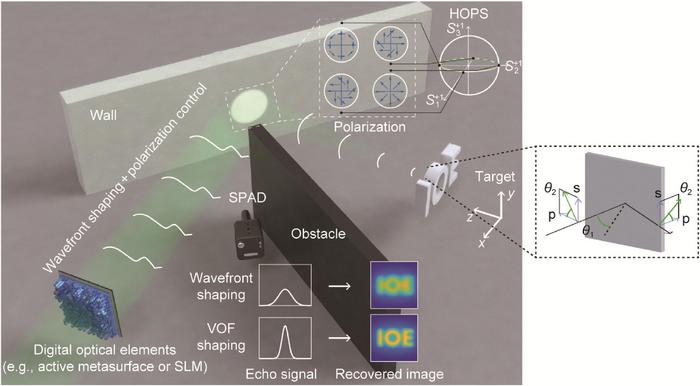
In the realm of advanced imaging technologies, a significant breakthrough has emerged through the introduction of vectorial digitelligent optics (VDO). This innovative approach to high-resolution non-line-of-sight (NLOS) imaging, as detailed in a recent publication in the journal Engineering, promises to redefine the way we perceive and capture images in challenging environments. Researchers have meticulously crafted a system that addresses the inherent limitations of traditional NLOS techniques, thereby vastly improving performance in diverse applications ranging from robotic vision to autonomous vehicle navigation.
Traditionally, NLOS imaging techniques have struggled with various challenges. For instance, the reliance on ultrafast time-resolved imagers has often come at the cost of high computational demands, which can be overwhelming. Furthermore, the echo signals frequently suffer from degradation in both intensity and shape, resulting in compromised resolution and contrast. The introduction of VDO seeks to mitigate these obstacles, allowing for clearer and more detailed imaging than previously obtainable.
One of the standout features of the VDO-empowered NLOS imaging system is its unique capacity to digitally manipulate the polarization state, phase, and amplitude of light beams. This sophisticated level of control is achieved through the utilization of digital optical elements, such as active metasurfaces or spatial light modulators (SLMs). In conjunction with robust deep learning algorithms, these elements work in harmony to project an engineered vector wavefront, which significantly offsets the spatially varying polarization and phase shifts that are typically a result of the relay wall’s interference.
During experimental validation, researchers employed a 532 nm picosecond fiber laser as the light source, coupled with an SLM for effective modulation of the light beam. The practical applications of this system were first showcased in single-object NLOS imaging, where reflective tape on a cardboard surface served as the subject. The outcomes were striking; the focal spot size measured at a full width at half maximum (FWHM) of 0.42 mm, which closely approaches the theoretical diffraction-limited spot size of 0.36 mm. Impressively, the peak signal-to-noise ratio (PSNR) exhibited a substantial average improvement of 6.9 times following VDO optimization, emphasizing the technique’s prowess in enhancing image quality.
Expanding on its capabilities, the VDO system was also tested in multi-object NLOS imaging scenarios. Two distinct objects were positioned at varying locations, and the time of flight (TOF) analysis of the photons allowed researchers to extract axial information. Despite the exciting developments, there were notable challenges, with the relative error in calculating the axial distance between the two objects hovering around 16.8%. This outcome underscores the necessity for ongoing refinement and development.
In an interesting twist, the researchers delved into polarization-selected NLOS imaging by varying the polarization state of the incident light. The findings were remarkable; selecting the proper polarization state resulted in an impressive 11.38% increase in the echo signal’s signal-to-noise ratio. Additionally, imaging results demonstrated enhanced contrast, coupled with improved restoration of object details, revealing the system’s capability to not only recover images but also elevate their quality significantly.
Despite these advancements, technical challenges remain, particularly in real-time signal reading from single-photon avalanche diodes (SPADs). Researchers are actively exploring alternative solutions, such as utilizing photomultiplier tubes and merging various optical elements to enhance system performance. The convergence of metasurface technology with NLOS imaging and other cutting-edge technologies indicates a promising horizon for further enhancing imaging speed and quality in future endeavors.
The implications of this research are vast, opening new pathways for applications in active imaging, advanced communication systems, and even laser wireless power transfer. The integration of VDO technology signals a shift in the paradigm of NLOS imaging, positioning it as a cornerstone for future innovations in optical engineering.
This study is authored by a collaborative team led by Yinghui Guo, alongside Yunsong Lei, Mingbo Pu, Fei Zhang, Qi Zhang, Xiaoyin Li, Runzhe Zhang, Zhibin Zhao, Rui Zhou, Yulong Fan, and Xiangang Luo. The culmination of their research not only highlights the advancements in imaging technology but also reinforces the importance of interdisciplinary cooperation in pushing the boundaries of what is possible in the optical sciences.
As the scientific community continues to explore the depths of vectorial digitelligent optics, it becomes increasingly clear that we are just scratching the surface of potential applications. The future may very well see VDO technology revolutionizing fields beyond traditional imaging, paving the way for novel innovations that leverage high-resolution optical systems in ways previously thought impossible.
In summary, the development of VDO showcases a transformative leap in the field of NLOS imaging. By addressing the critical challenges that have historically hindered the clarity and quality of captured images, this innovative technology lays the groundwork for significant advancements across various sectors, making it a pivotal discovery in modern optics.
Subject of Research: High-Resolution Non-Line-of-Sight Imaging
Article Title: Vectorial Digitelligent Optics for High-Resolution Non-Line-of-Sight Imaging
News Publication Date: 28-Nov-2024
Web References: https://doi.org/10.1016/j.eng.2024.11.013
References: Yinghui Guo, Yunsong Lei, Mingbo Pu, Fei Zhang, Qi Zhang, Xiaoyin Li, Runzhe Zhang, Zhibin Zhao, Rui Zhou, Yulong Fan, Xiangang Luo.
Image Credits: Yinghui Guo et al.
Keywords
High-Resolution Imaging, Non-Line-of-Sight Imaging, Vectorial Digitelligent Optics, Advanced Optical Systems.
Tags: advancements in imaging technologiesapplications of non-line-of-sight imagingautonomous vehicle navigation imagingchallenges in traditional NLOS techniquesdigital optical elements in imaginghigh-resolution non-line-of-sight imagingimproving imaging resolution and contrastinnovative imaging solutions for challenging environmentspolarization state manipulation in opticsrobotic vision advancementsspatial light modulators in NLOS imagingvectorial digitelligent optics breakthrough





